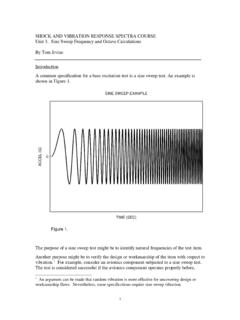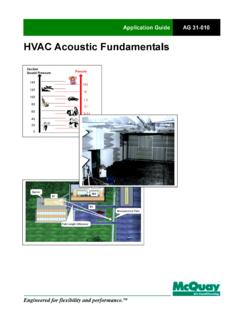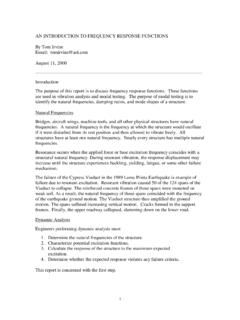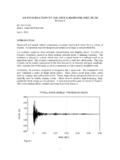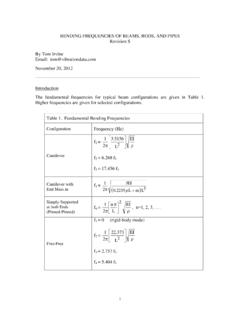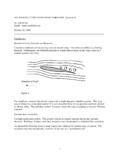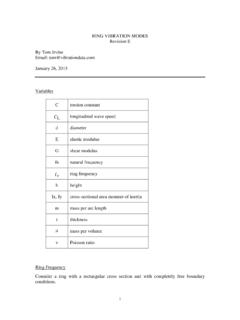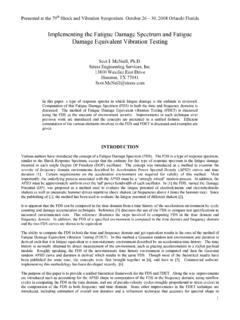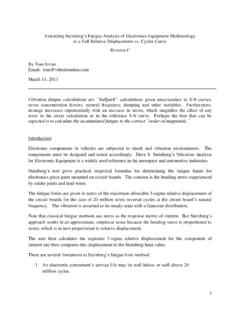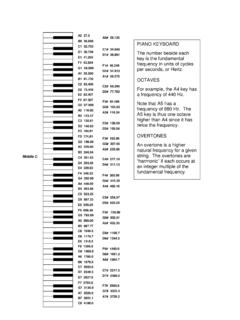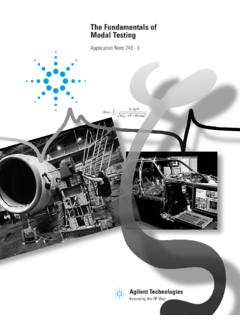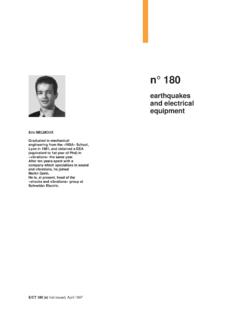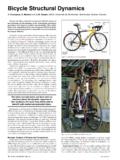Transcription of d for judging the “significance” of a vibration
1 1 EFFECTIVE modal MASS & modal PARTICIPATION FACTORS Revis ion I By Tom Irvine Ema il: December 11, 2015 _____ Introduction The effective modal mass provides a method for judging the significance of a vibration mode. Modes w ith re lative ly high effective masses can be readily exc ited by base excitation. On the other hand, modes w ith low effective masses cannot be readily e xcited in this manner. Cons ider a moda l tra ns ient or frequency response function ana lys is via the finite ele ment method. Als o cons ider that the system is a multi-degree-of-freedom system. For brevity, only a limited number of modes should be inc luded in the analys is. How many modes should be inc luded in the analys is? Perhaps the number should be enough s o that the tota l effective moda l mass of the mode l is at least 90% of the actua l mass.
2 Definitions The equation definitions in this section are taken from Reference 1. Cons ider a discrete dyna mic system governed by the follow ing equation FxKxM (1) where M is the mass matrix K is the stiffness matrix x is the acceleration vector x is the dis placement vector F is the forc ing function or base excitation function 2 A solution to the homoge neous form of equation (1) can be found in terms of e igenva lues and eigenvectors. The eigenvectors represent vibration modes. Let be the eigenvector matrix. The system s generalized mass matrix m is given by MTm (2) Let r be the influence vector which represents the dis placements of the masses resulting from static application of a unit ground displacement.
3 The influence vector induces a rigid body motion in all modes. Define a coeffic ient vector L as rMTL (3) The moda l partic ipation factor matrix i for mode i is iim iLi (4) The effective moda l mass i,effm for mode i is ii2ii,effm Lm (5) Note that iim = 1 for each inde x if the eige nvectors have been norma lized with respect to the mass matrix. Furthermore , the off-diagona l moda l mass ( ji,m ji ) terms are zero regardless of the normalization and even if the phys ical mass matrix M has distribute d mass.
4 This is due to the orthogona lity of the e igenvectors. The off-diagona l moda l mass terms do not appear in equation (5), however. An example for a system with distributed mass is show n in Appendix F. 3 Example Cons ider the tw o-degree-of-freedom system show n in Figure 1, w ith the parameters shown in Table 1. Figure 1. The homogeneous equation of motion is 002x1x3k2k3k3k3k1k2x1x2m001m (6) The mass matrix is kg1002M (7) Table 1. Parameters Variable Value 1m kg 2m kg 1k 1000 N/m 2k 2000 N/m 3k 3000 N/m m1 k1 m2 k2 k3 x1 x2 y 4 The stiffness matrix is m/N5000300030004000K (8) The eige nva lues and e ige nvectors can be found us ing the method in Reference 2.
5 The eige nva lues are the roots of the follow ing equation. 0M2 Kdet (9) The eige nva lues are 2 (10) (11) (12) 2sec/rad609822 (13) (14) (15) The eige nvector matrix is (16)
6 5 The e igenvectors were previous ly norma lized s o that the ge neralized mass is the identity matrix. MTm (17) (18) (19) 1001m (20) Again, r is the influence vector which re presents the displacements of the masses resulting from static application of a unit ground dis placement. For this example, each mass simply has the same static displacement as the ground dis placement. 11r (21) The coeffic ient vector L is rMTL (22) (23) 6 (24) (25) The moda l partic ipation factor i for mode i is iim iLi (26) The moda l partic ipation vector is thus (27)
7 The coeffic ient vector L and the moda l partic ipation vector are identica l in this example because the generalized mass matrix is the identity matrix. The effective moda l mass i,effm for mode i is iim 2iLi,effm (28) For mode 1, ,effm (29) ,effm (30) 7 For mode 2, ,effm (31) ,effm (32) Note that ,effm1,effm (33)
8 Kg32,effm1,effm (34) Thus , the sum of the effective masses equals the tota l system mass. Also, note that the first mode has a much higher effective mass than the second mode. Thus , the first mode can be readily e xcited by base exc itation. O n the other hand, the second mode is negligible in this sense. From another viewpoint, the center of gravity of the first mode experiences a significant translation whe n the first mode is excited. On the other hand, the center of gravity of the second mode rema ins nearly stationary when the second mode is exc ited. Each degree-of-freedom in the previous example was a trans lation in the X-a xis. This characteristic s implifie d the effective moda l mass calculation. In ge neral, a s ystem w ill have at least one trans lation degree-of-freedom in each of three orthogona l axes.
9 Likew ise, it w ill have at least one rotationa l degree-of-freedom about each of three orthogona l axes. The effective modal mass calculation for a general s ystem is shown by the example in Appendix A. The example is from a real-world problem. 8 Aside An alternate definition of the partic ipation factor is given in Appendix B. References 1. M. Papadrakakis , N. Lagaros, V. Ple vris; Optimum Des ign of Structures under Seis mic Loading, European Congress on Computationa l Methods in Applied Sciences and Engineering, Barcelona, 2000. 2. T. Irvine, The Ge neralized Coordinate Method For D iscrete Systems, Vibrationdata, 2000. 3. W. Thomson, Theory of V ibration w ith Applications 2nd Edition, Prentice Hall, New Jersey, 1981. 4. T. Irvine, Bending Frequenc ies of Beams, Rods, and Pipes, Rev M, V ibrationdata, 2010. 5.
10 T. Irvine, Rod Response to Longitudina l Base Excitation, Steady-State and Transient, Rev B, V ibrationdata, 2009. 6. T. Irvine, Longitudinal Vibrat ion of a Rod via the F inite Element Method, Revision B, Vibrationdata, 2008. 9 APPENDIX A Equation of Motion, Isolated Avionics Component Figure A-1. Isolated Avionics Component Mode l The mass and inertia are represented at a point w ith the circ le symbol. Each isolator is modele d by three orthogona l DOF springs. The springs are mounted at each corner. The springs are shown w ith a n offset from the corners for c larity. The tria ngles indicate fixed constraints. 0 indicates the origin. ky4 kx4 kz4 ky2 kx2 ky3 kx3 ky1 kx1 kz1 kz3 kz2 m, J 0 x z y 10 Figure A-2. Isolated Avionics Component Mode l with D ime ns ions All dimensions are positive as long as the is inside the box.
